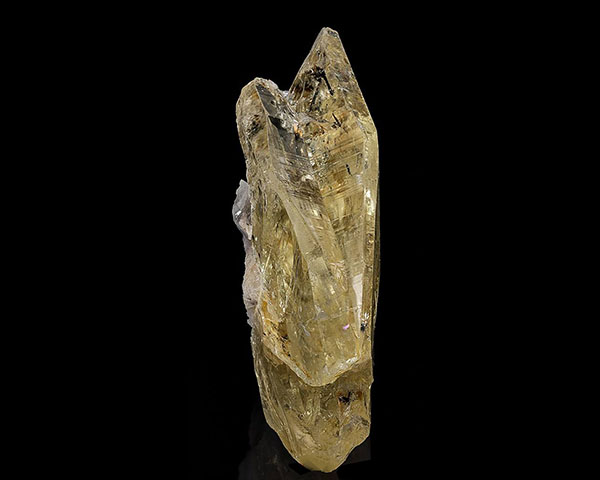Amblygonite comes from the Greek words “blunt” and “angle”, which means that it has the shape of crystals.
Amblygonite is a rare gem mineral. Because of its poor quality and color, many people use it as an ornamental stone or a collection, but few use it as a gem.
- Color: white, slightly light green, light blue, yellow, orange and pink.
- Gloss: glass luster, cleavage mask pearl luster,
- Transparency: translucent to transparent.
- Dissociation: Cleavages{ 100} and {110} are complete.
- Hardness: 5.5~6,
- Density: 2.92~3.15 g/cm. Colorless under transmitted light.
- Optical Property: biaxial crystal, optical Property depends on the content of F, (OH); if the additional anion is F, it is negative, and its optical axis angle is small; If it is (OH), it is positive and its optical axis angle is large; if the content is between the two, it can be positive or negative.
- Refractive index: Ng=1.616, Nm=1.608, Np=1.594. Birefringence 0.022.

Basic Property of Amblygonite
Chemical composition
The chemical formula of Amblygonite is (Li, Na) A1 (PO4) (F, OH), which is a phosphate of lithium aluminum. The lithium in the composition can often be replaced by sodium. When OH>F, this mineral can be called Montebrasite.
Morphology
amblygonite belongs to the triclinic system, with space group ao=5.129, bo=7.12, co=5.04A; a=112°02’, β= 97°49’, γ= 68°07’; Z=2。 Spectral lines of main powder crystals: 4.64 (100), 3.151 (100), 2.925 (100). The single crystal is fine, the appearance is equiaxed, and the polycrystals are common; It is usually a dense massive aggregate.
Physical characteristics
Glass luster to grease luster, cleavage surface pearl luster, transparent to translucent, usually colorless to light yellow, rarely green, blue, brown and pink.
The biaxial crystal has negative phototropism (some have positive phototropism), and the polychromatic is not weak, depending on the color.
The refractive index is Np=1.591, Nm=1.605, Ng=1.612 ± 0.010, and the birefringence is 0.020 ~ 0.027. It can emit very weak green fluorescence under long-wave light and light blue phosphorescence under long-wave light and short-wave light.
With {100} {110} two groups of complete cleavage, the fracture is shell-shaped, the Mohs hardness is 5.5~6, the density is 3.02 (± 0.04) g/cm, and the powder can slowly dissolve in hydrochloric acid.
How to identify Amblygonite
When Enlarged and observe, it has liquid inclusions, and there may also be cloud-like substances parallel to the cleavage direction. It can be identified by refractive index, density, birefringence and optical characteristics.
Where is Amblygonite from
Gem-grade amblygonite crystals occur in granite and pegmatite, and coexist with lepidolite, spodumene, tourmaline, etc.
Countries in the world producing gem-grade Amblygonite are Brazil, the United States, Myanmar, Namibia, Norway, Germany, France, Sweden, Spain, etc. For example, Minas Gerais, Brazil, produces yellow and orange amblygonite crystals, the United States and Myanmar produce yellow Amblygonite, and Namibia produces lilac-violet Amblygonite.
Amblygonite has been found in granite pegmatites in Xinjiang, Inner Mongolia and other places in China.
Comparison between Amblygonite and Montebrasite
Amblygonite
Amblygonite is phosphate containing F, (OH) lithium and aluminum in nature. Because F and (OH) can form a complete isomorphism, it can be divided into two subspecies: Amblygonite (LiAL [PO4] F) and Montebrasite [ LiAL(PO4)(OH, F)].
If it is used as a gem, the crystal should be colorless, bright, transparent and large in size. Faceted gemstones have appeared on the market, with yellow ones weighing more than 20~60 carats and colorless ones weighing about 3 carats.
Amblygonite is mainly produced in granite pegmatite and coexists with lepidolite, kunzite, apatite, tourmaline, etc. The crystals vary in size, and some are huge.
montebrasite
The variety with high base content in the Amblygonite (the additional anion in the Amblygonite is mainly F). The chemical formula is LiAL (PO4) (OH, F).
Compared with Amblygonite, its refractive index and refractivity are higher and tend to be positive; The relative density is relatively low, about 2.98. Kalibib, Namibia, produces beautiful lilac-purple crystals.
Conclusion:
Amblygonite is a phosphate mineral of lithium aluminum. It belongs to the Tricline system, with short columnar crystals and commonly double crystals or dense massive aggregates. The colors are mainly colorless and light yellow, but also gray-white, light pink, brown, light green and lake blue. Gem-grade crystals mainly occur in granite pegmatites. Transparent to translucent, glassy to greasy luster, cleavage surface is pearly luster.
It is mainly produced in Brazil, the United States, Sweden, Canada and Germany. Brazil produces high-quality yellow gem-grade crystals and massive aggregates. There is a 41.9-carat yellow amblygonite gem made in Brazil in The Smithsonian Museum in Washington, USA,
The variety with high base content in Amblygonite is called Montebrasite, which is produced in Namibia and has beautiful lilac purple.
